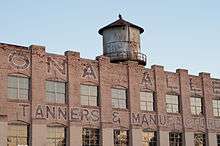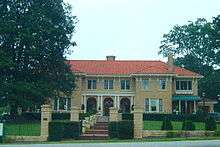Bona Allen Company


The Bona Allen Company is a tannery that opened in 1873 in Buford, Georgia. As the nation's largest tannery, the company made horse collars and saddles, postal bags, cowboy boots, shoes and more. It also had a contract to supply the sporting equipment giant, Spalding, with raw material for the manufacture of baseballs and baseball mitts.[1] The Bona Allen Company was owned by Bonaparte Allen. Also known as the Bona Allen Shoe and Horse Collar Factory, the factory closed in 1981 after a fire, and the main tannery building was added to the National Register of Historic Places on January 3, 2005.[2] It is located at 554 West Main Street. After another fire on February 10, 2015, firefighters allowed the building to burn itself down.
History
Bonaparte Allen learned the trade of tanning from his father, Washington Allen. Bonaparte opened the Bona Allen Company at the age of 27 and operated it as a tannery and leather goods shop. It started off making whiplashes, then followed with the production of horse collars. In 1903, a fire swept through the building and destroyed the business and the entire building. Allen lost everything. But, thanks to his established business track record, a local bank loaned him the money he needed to re-establish and rebuild his business. It didn't take Bonaparte long to restore his thriving business and pay off all of his debt.
In 1925, Bonaparte Allen died. He left everything to his sons, Bona Jr., John, and Victor. They took over their father's business and continued to produce what some people have deemed the country’s finest leather. The Great Depression of the early 1930s had a positive effect on the Company's tannery. The nation's farmers could no longer afford to operate their tractors, so they had to return to using horses. This, in turn, created a demand for saddles and collars, as well as all other horse related equipment.[3]
The Bona Allen Company continued to expand and soon was selling groceries and dried goods in addition to its leather products. In 1933, a Bona Allen saddle won a blue ribbon at the Chicago World’s Fair. At the fair, The Bona Allen Company provided several jobs as well as entertainment; it sponsored many sports events and teams such as basketball, football, and the Bona Allen Company's own baseball team. In 1941, a strike was called and shut down the Company's shoe plant. Six months later, the government stepped in and reopened the shoe plant to repair army shoes. The Company's collar factory was closed for good after WWII.[4]
The Bona Allen Company received special acclaim in the 1950s for production of its classic saddles. During the peak of western movies, many of Hollywood's famous cowboy actors, including Roy Rogers, William F. ("Buffalo Bill") Cody, Gene Autry, Kenny Rogers, Lash LaRue, Gabby Hayes, and the cast of the popular TV show "Bonanza, " preferred a Bona Allen saddle—some even bringing their horses to Buford, Georgia, to get them custom fitted.[5] To head its saddle department, the Company hired Victor Alexander, a famous saddle expert from the King Ranch in Texas.[6] Under his management, the Bona Allen Company produced some of the finest hand-tooled saddles and bridles ever made, including a silver-studded special order saddle for Roy Rogers.[7]
Bonaparte Allen also owned up to 200 houses that he would rent to his employees; the houses would typically rent for $4.00 to $12.00 per month. Some employee could buy them with no down payment. In 1932, the Bona Allen Company hit the peak of its employment: 2,200 people worked there until rough times hit in 1943, when it closed its horse collar factory, shoe and chrome tannery—dropping its total employee headcount to 500.[8] Following the death of John Allen in 1968, the tannery and saddle and harness factories were sold to Tandy Corporation. The railroad depot closed in 1972, and the demand for horse-related leather goods decreased. While Tandy Corp. continued operations for a few years under the Bona Allen name, after the devastating tannery fire in December 1981, they chose not to rebuild, and the last of the Bona Allen Company's 160 employees were let go.[9]
On February 10, 2015, a warehouse caught fire. Gwinnett County allowed the building to burn itself out, citing dangers from leftover chemicals.[10]
Military shoemaking
In 1918, The Bona Allen Tannery expanded into shoes and boots. It was profitable at first, but production was cut during the Great Depression. Labor unrest forced Allen's sons to end production in 1941, but the factory was reopened at the request of the federal government during World War II to make footwear for the United States military.
Bona Allen Shoemakers
In the 1930s, factories and mills across the nation sponsored semi-pro baseball teams to advertise their businesses, provide affordable entertainment and serve as a source of civic interest and community pride. Major league baseball had only 16 teams, and semi-pro baseball teams grew in popularity.[11] John Q. Allen, a son of Bona Allen, arranged for The Bona Allen Shoe Company to sponsor one of the finest semi-pro teams in US history, known as The Bona Allen Shoemakers. In 1933, the Shoemakers won 56 of its 61 games.
The Bona Allen Shoemakers were a semi-pro industrial league baseball team sponsored by the Bona Allen Shoe Company. They were active during the late 1920s through the early 1940s when World War II began. Their most successful years were the late '30s and early '40s. They won the 1938 national semi-pro championship held in Wichita, Kansas, as well as the Denver Post Baseball Tournament championship in 1940.[12]
Monuments
A statue of Roy Rogers, his horse Trigger, and saddle-maker Jack Johnson now stands in downtown Buford’s park as a tribute to the tannery.[13] This statue, across the street from the Buford, Georgia, based tannery recreates Roy Rogers and a Bona Allen employee putting a newly purchased saddle on Rogers' horse Trigger. The story behind the statue began when Roy Rogers and Trigger rode east on a private train for Trigger to be fitted for one of Bona Allen’s renowned saddles. The statue features Trigger rearing, with Rogers in pointed boots and western gear standing to the side and the saddle craftsman, Jack Johnson, standing on the other.[14]
Historic Homes

The Bona Allen Mansion, originally on 1,700 acres, has been listed on the National Register of Historical Places. The home was designed by Atlanta architect Haralson Bleckley. The main house has 17 rooms, 12-foot ceilings, original carved wood paneling, moldings, stained glass windows and seven fireplaces. The two-story entry showcases an original Italian wall mural of the Castello Villa Franca in South Rome.
The John Q. Allen Home Located on Main Street between the Bona Allen Mansion and the Bona Allen, Jr. home, the John Q. Allen home was built between 1911 and 1912 and is in the Georgian Revival style. It is on the National Register of Historic Places.
Sale to Tandy Corporation
In 1968 the Bona Allen Tannery was sold to Tandy Corporation, which owned leather goods stores.[15]
See also
References
- ↑ "Archived copy". Archived from the original on 2011-07-14. Retrieved 2010-06-04.
- ↑ http://www.nps.gov/nr/listings/20050121.htm
- ↑ http://www.tributeamericanmade.com/bona_allen.html
- ↑ http://www.visitbuford.com/History.html[]
- ↑ "Archived copy". Archived from the original on 2009-10-27. Retrieved 2009-10-08.
- ↑ http://www.tributeamericanmade.com/hollywood.html
- ↑ http://www.flickr.com/photos/robertlz/465050310/
- ↑ http://www.gainesvilletimes.com/news/archive/16428/
- ↑ "Archived copy". Archived from the original on 2009-10-27. Retrieved 2009-10-08.
- ↑ "Major blaze may spell end of Buford landmark". Atlanta Journal-Constitution. February 10, 2015. Retrieved 11 February 2015.
- ↑ http://www.baseballink.com/archives/stories/the-bona-allen-shoemakers-4069
- ↑ "Archived copy". Archived from the original on 2011-07-14. Retrieved 2010-06-04.
- ↑ http://www.gainesvilletimes.com/news/archive/16428/
- ↑ "Archived copy". Archived from the original on 2014-02-24. Retrieved 2014-02-05.
- ↑ "Archived copy". Archived from the original on 2014-02-24. Retrieved 2014-02-05.
External links
- Bona Allen Tannery
- About Buford, Georgia
- About The Bona Allen Company
- The Museum of Buford, Georgia